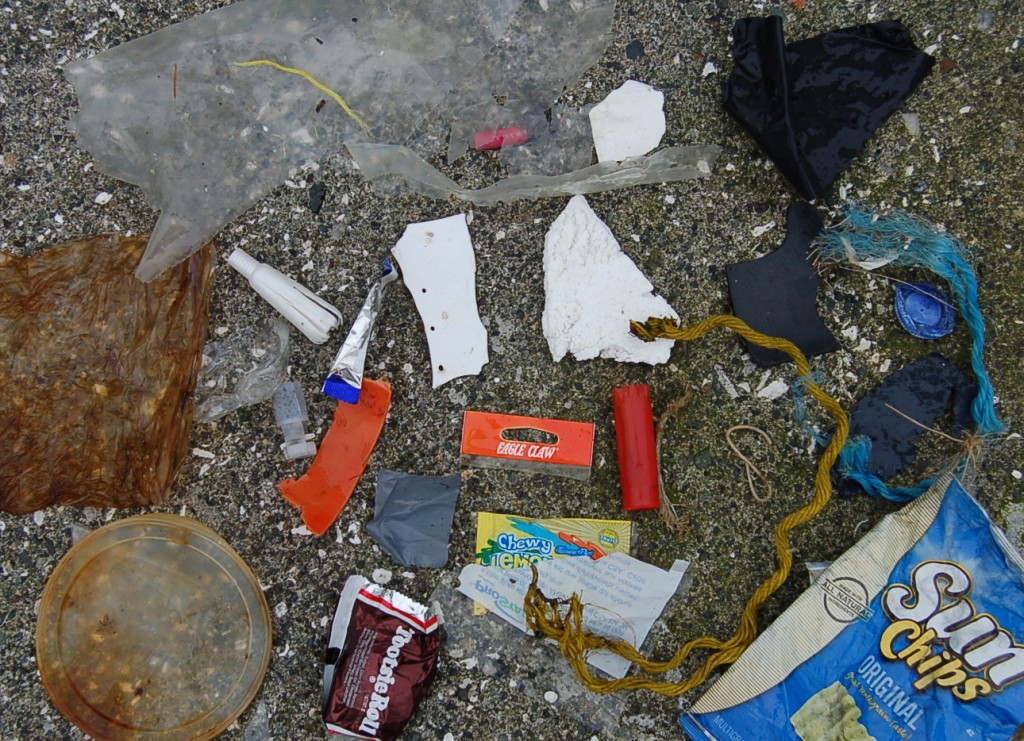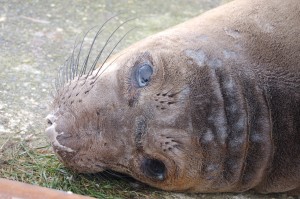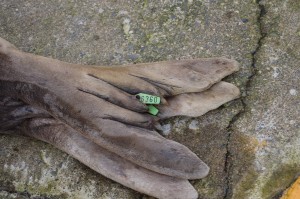Looks like X 948. The animal is in good shape up on the lawn near the student house but did get a bit too close to the island’s king, thus the blood… No worries though, just a scratch.

There are six E-seals on the island today. The big bull Misery, Bertha, a seemingly very pregnant large female with a distinct scar on her belly, and four youngsters resting uncomfortably on the rubble beach near the engine room.
The scruffy pup closest in the picture has a green hind flipper tag. The number appears to be #6355. I will look for info about from where and whence it cometh
Over 60 black oystercatchers (Haematopus bachmani) are on the rocks on the south perimeter of the big island.Never have I seen a flock like this! Usually a person is lucky to see 10 together at a time. Along with the Haemas are about 40 Blackheaded Turnstones (Arenaria melanocephala).
2 divers in the water at West Rock. An Italian student and her friend are out for 3 days, as is another guest who is a professional photographer. I will try and get some good pics of the seals from her…
Misery has been on Middle Rock Tuesday and Wednesday but was back by the boat house this morning.
There were over 40 Harbour Seals observed on the south side of the island and South Rock this afternoon.
Have had 3 days of grey skies and a sustained lack of precipitation. The wind peaked just over 20 knots on Tuesday and has stayed around 10 knots yesterday and today. Atmospheric pressure reached its lowest point in the past two weeks on Tuesday around 1015 hPa and has been on the rise today.
This morning I counted over 200 cormorants on the South Rocks and saw a pair of Harlequin ducks by the jetty.
The female elephant 6360 went back in the water before noon. Misery was near the centre of the island at sunset.
I went off island to campus around noon. I brought some scientific instruments back to campus and went into Langford to pick up plumbing parts and other supplies. Erik worked on the whaler’s fuel line over the afternoon and got it fixed up. I got back out to the island as the sun was setting on the lowest tide I have ever landed on out here, the boat ramp was longer than usual.
From bed I watched Misery haul himself up the boat ramp around 7:30 this morning. He had spent the last week lying on Middle Rocks along with two female elephant seals. Over the course of the morning he made his way past the boat house and along the North side of the Student Centre before coming to rest on the North side of the Solar/Engine room this afternoon.
The female with the green tag No. 6360 was also hauled this morning, she stayed on the rocks next to the jetty all day.
Pam has a image capture on her flickr page taken from the webcam in the tower on Saturday of 6360 and the other female elephant seal on Middle Rocks
I counted over 40 cormorants on the South Rocks this afternoon and I couldn’t even see how many were on the south side of that island. Pam has a great photo here from a few days ago of Cormorants preening on the South Rocks.
The NE wind and falling tide left a lot of garbage around the jetty today. I wonder what it feels like when animals accidentally swallow this stuff.

The female elephant seal has stayed on the boat launch all day. She changed position and I was able to see her ID tag # 6360.

Misery is currently hauled out on one of the West Rocks along with about 30 sea lions. He has not been back on Great race for several days. There were also around 10 sea lions on East Rock today.
A new arrival TOPP#6375 was photographed on the S side of Great Race.
Total Elephant Seals: 5 (Ryan)
-241, ‘2011-09-26’, ‘Elephant Seal’, 1, ‘Small female TOPP tag 6375 is hauled out at the jetty.’, ‘Ryan’, ’16:41:39
black oystercatcher count : 26, The most I’ve seen this time of year.
Elephant Seal: 1Small female TOPP tag 6375 is hauled out at the jetty.
‘Our three newest black oystercatcher chicks are doing quite well. They ”ve left the nest and are now in the rocky area just beside the jetty. There are several other families on this side of the island, notably one beside the winch house and one in the east bay. There’s also a family or two over in the west surge channel. Most gulls have now settled down into their nests with mating coming to a close. Pam reports a nest up near the fresh water pool is about to hatch; be sure to keep your eye on that one over the next few days! I ”ve noticed on several occasions some broken eggs scattered on the grass around the island. Probable cause: the otter. I saw it scampering across the winch pad the other evening, much to the gulls ” discontentment. There ”s also a dead gull up beside the base of the tower; it ”s been there for a few days now considering the state of decomposition. I expect that it was killed in a territorial fight. Gulls are very territorial birds and will aggressively defend an area of about one metre in radius -with exceptions) around their nest. Any other gull who infringes upon this territory will be the subject of an intense attack – by the owners of that piece of waterfront real estate. Territorial defence is actually one of the reasons why it is important to keep human traffic down in the reserve during gull season: once chicks hatch, any disturbances that cause them to stray from their native territory into another family ”s territory will result in retaliation by the adults of that foreign territory. Chicks are usually helpless to the attacks and will be ruthlessly killed. We have three elephant seals hauled up on Great Race: Misery is up near the engine room, Bertha is behind the tank room and #4252 is on the concrete area at the top of the jetty. 4252 seems to be a bit unwell these days; I ”ve recently observed her breathing heavily and coughing, and her spittle is often flecked with blood. Garry suggests that she could be going through her moult; however, females typically moult in April and May, sub-adult males moult in May and June and adult males moult in July and August. Considering that Misery has now completed his moult and is a breeding male, I ”d expect that 4252, a young female, certainly would have by now. I ”ll be keeping my eye on her over the next bit. There is still an elephant seal out on Middle Rock. Bertha is now most likely approaching the beginning of her seven month gestation period. Female elephant seals come into heat 24 days after giving birth. However, after mating, the fertilized egg does not implant in the wall of the uterus for up to four months, a rare phenomenon called “delayed implantation “. The currently favoured theory is that the female is to weak after giving birth and nursing that she doesn’t have enough energy to nurture the egg. However, once implantation does occur, the actual gestation period is seven months. This gives a total of eleven months and explains the yearly cycle we see. So, if Bertha gave birth and mated in late February, her egg is most likely reaching the implantation stage right now, late June. I expect that in a few weeks gestation will be well underway. I saw a hummingbird pass by my window this morning. I ”m not sure how common they are around here. Unfortunately I couldn’t get a picture as it only briefly flew by. Sea lions are at a seasonal low right now as the California variety move south to breed for the summer while most of the northern variety move northwards for the summer.’, ‘adam’, ’11:28:56 ,